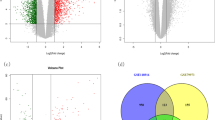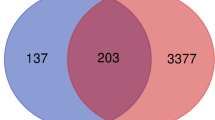Abstract
Gastric cancer is the third most common cause of cancer-related death in worldwide. It is crucial to target the key genes controlling pathogenesis in the early stage of gastric cancer. This study describes an integrated bioinformatics to identify molecular biomarkers for gastric cancer in patients’ cancer tissues. We reports differently expression genes in large gastric cancer cohorts from Gene Expression Ominus (GEO). Our findings revealed that 433 genes were significantly different expressed in human gastric cancer. Differently expression gene profile in gastric cancer was further validated by bioinformatic analyses, co-expression network construction. Based on the co-expression network and top-ranked genes, we identified collagen type I alpha 2 (COL1A2) which encodes the pro-alpha2 chain of type I collagen whose triple helix comprises two alpha1 chains and one alpha2 chain, was the key gene in a 37-gene network that modulates cell motility by interacting with the cytoskeleton. Furthermore, the prognostic role of COL1A2 was determined by use of immunohistochemistry on human gastric cancer tissue. COL1A2 was highly expressed in human gastric cancer as compared with normal gastric tissues. Statistical analysis showed COL1A2 expression level was significantly associated with histological type and lymph node status. However, there were no correlations between COL1A2 expression and age, lymph node numbers, tumor size, or clinical stage. In conclusion, the novel bioinformatics used in this study has led to identification of improving diagnostic biomarkers for human gastric cancer and could benefit further analyses of the key alteration during its progression.



Similar content being viewed by others
References
Orditura M, Galizia G, Sforza V, Gambardella V, Fabozzi A, Laterza MM, Andreozzi F, Ventriglia J, Savastano B, Mabilia A, Lieto E, Ciardiello F, De Vita F (2014) Treatment of gastric cancer. World J Gastroenterol 20:1635–1649
Lee YY, Derakhshan MH (2013) Environmental and lifestyle risk factors of gastric cancer. Arch Iran Med 16:358–365
Chandanos E, Lagergren J (2008) Oestrogen and the enigmatic male predominance of gastric cancer. Eur J Cancer 44:2397–2403
Qin J, Liu M, Ding Q, Ji X, Hao Y, Wu X, Xiong J (2014) The direct effect of estrogen on cell viability and apoptosis in human gastric cancer cells. Mol Cell Biochem 395:99–107
Gonzalez CA, Sala N, Rokkas T (2013) Gastric cancer: epidemiologic aspects. Helicobacter 18(Suppl 1):34–38
Hatakeyama M, Higashi H (2005) Helicobacter pylori CagA: a new paradigm for bacterial carcinogenesis. Cancer Sci 96:835–843
Thrumurthy SG, Chaudry MA, Hochhauser D, Mughal M (2013) The diagnosis and management of gastric cancer. BMJ 347:f6367
Chan TH, Qamra A, Tan KT, Guo J, Yang H, Qi L, Lin JS, Ng VH, Song Y, Hong H et al: ADARMediated RNA Editing Predicts Progression and Prognosis of Gastric Cancer. Gastroenterology 2016; 151(4):637–650 e610
Kataoka K, Shiraishi Y, Takeda Y, Sakata S, Matsumoto M, Nagano S, Maeda T, Nagata Y, Kitanaka A, Mizuno S, Tanaka H, Chiba K, Ito S, Watatani Y, Kakiuchi N, Suzuki H, Yoshizato T, Yoshida K, Sanada M, Itonaga H, Imaizumi Y, Totoki Y, Munakata W, Nakamura H, Hama N, Shide K, Kubuki Y, Hidaka T, Kameda T, Masuda K, Minato N, Kashiwase K, Izutsu K, Takaori-Kondo A, Miyazaki Y, Takahashi S, Shibata T, Kawamoto H, Akatsuka Y, Shimoda K, Takeuchi K, Seya T, Miyano S and Ogawa S. Aberrant PD-L1 expression through 3′-UTR disruption in multiple cancers. Nature 2016; 534: 402–406.
Burki TK: Progression-free survival with regorafenib in gastric cancer. The Lancet Oncology 2016; 17(8):e323
Venturi S, Donati FM, Venturi A, Venturi M (2000) Environmental iodine deficiency: a challenge to the evolution of terrestrial life? Thyroid 10:727–729
Jakszyn P, Gonzalez CA (2006) Nitrosamine and related food intake and gastric and oesophageal cancer risk: a systematic review of the epidemiological evidence. World J Gastroenterol 12:4296–4303
Barker N, Huch M, Kujala P, van de Wetering M, Snippert HJ, van Es JH, Sato T, Stange DE, Begthel H, van den Born M, Danenberg E, van den Brink S, Korving J, Abo A, Peters PJ, Wright N, Poulsom R, Clevers H (2010) Lgr5(+ve) stem cells drive self-renewal in the stomach and build long-lived gastric units in vitro. Cell Stem Cell 6:25–36
Ohtsu A, Ajani JA, Bai YX, Bang YJ, Chung HC, Pan HM, Sahmoud T, Shen L, Yeh KH, Chin K, Muro K, Kim YH, Ferry D, Tebbutt NC, Al-Batran SE, Smith H, Costantini C, Rizvi S, Lebwohl D, Van Cutsem E (2013) Everolimus for previously treated advanced gastric cancer: results of the randomized, double-blind, phase III GRANITE-1 study. J Clin Oncol 31:3935–3943
Wang K, Yuen ST, Xu J, Lee SP, Yan HH, Shi ST, Siu HC, Deng S, Chu KM, Law S, Chan KH, Chan AS, Tsui WY, Ho SL, Chan AK, Man JL, Foglizzo V, Ng MK, Chan AS, Ching YP, Cheng GH, Xie T, Fernandez J, Li VS, Clevers H, Rejto PA, Mao M, Leung SY (2014) Whole-genome sequencing and comprehensive molecular profiling identify new driver mutations in gastric cancer. Nat Genet 46:573–582
Ramucirumab extends gastric cancer survival. Cancer Discov 2014; 4: OF3.
Garay J, Piazuelo MB, Majumdar S, Li L, Trillo-Tinoco J, Del Valle L, Schneider BG, Delgado AG, Wilson KT, Correa P et al: The homing receptor CD44 is involved in the progression of precancerous gastric lesions in patients infected with Helicobacter pylori and in development of mucous metaplasia in mice. Cancer letters 2016; 371(1):90–98
Cristescu R, Lee J, Nebozhyn M, Kim KM, Ting JC, Wong SS, Liu J, Yue YG, Wang J, Yu K, Ye XS, Do IG, Liu S, Gong L, Fu J, Jin JG, Choi MG, Sohn TS, Lee JH, Bae JM, Kim ST, Park SH, Sohn I, Jung SH, Tan P, Chen R, Hardwick J, Kang WK, Ayers M, Hongyue D, Reinhard C, Loboda A, Kim S, Aggarwal A (2015) Molecular analysis of gastric cancer identifies subtypes associated with distinct clinical outcomes. Nat Med 21:449–456
Schlaermann P, Toelle B, Berger H, Schmidt SC, Glanemann M, Ordemann J, Bartfeld S, Mollenkopf HJ, Meyer TF (2016) A novel human gastric primary cell culture system for modelling helicobacter pylori infection in vitro. Gut 65:202–213
Tabata S, Ikeda R, Yamamoto M, Shimaoka S, Mukaida N, Takeda Y, Yamada K, Soga T, Furukawa T, Akiyama S (2014) Thymidine phosphorylase activates NFκB and stimulates the expression of angiogenic and metastatic factors in human cancer cells. Oncotarget 5:10473–10485
Kim SY, Park C, Kim HJ, Park J, Hwang J, Kim JI, Choi MG, Kim S, Kim KM, Kang MS (2015) Deregulation of immune response genes in patients with Epstein-Barr virus-associated gastric cancer and outcomes. Gastroenterology 148:137–147 e139
Acknowledgments
We thank Department of gastroenterology, Chongqing Infectious Disease Medical Center for providing study data.
Author information
Authors and Affiliations
Corresponding author
Ethics declarations
Conflict of Interest
No potential conflicts of interest were disclosed.
Rights and permissions
About this article
Cite this article
Rong, L., Huang, W., Tian, S. et al. COL1A2 is a Novel Biomarker to Improve Clinical Prediction in Human Gastric Cancer: Integrating Bioinformatics and Meta-Analysis. Pathol. Oncol. Res. 24, 129–134 (2018). https://doi.org/10.1007/s12253-017-0223-5
Received:
Accepted:
Published:
Issue Date:
DOI: https://doi.org/10.1007/s12253-017-0223-5




